|
SOLAR ECLIPSES:

Solar eclipse video.
(Image used by permission, Fred Espenak (aka
MrEclipse)).
What causes solar eclipses?
Remember that all heavenly bodies have shadows and since the Sun is the source of light all shadows are opposite the
Sun in our solar system.

Top view of shadows.
A solar eclipse is caused by the Earth passing through the Moon's shadow. Since the Moon's orbit is tilted by 5
degrees, we do not have a solar eclipse every time there is a New Moon. We only have solar eclipses when the wobble of
the Moon's orbit brings the Moon perfectly between the Earth and the Sun. By the way, solar eclipses also occur about
twice a year!
Simple enough. However, remember that shadows have 2 parts: the umbra and the penumbra. The umbra is the center and
darkest part of the shadow. While the penumbra is the outer and lighter part of the shadow (the penumbra is so light
that we hardly notice it on Earth). Also, to complicate things even more, the Moon's orbit is NOT a circle! It
is an ellipse. So, let's look at circles and ellipses for a minute.
Here's a trick to drawing a circle. Take a tack and stick it into a piece of paper (where you want the center of the
circle to be - sometimes called the focus). Take a piece of string and tie it into a loop. The radius of the
circle will be the length of the loop of string. Now put one end of the loop over the tack and the other end of the
loop over a pencil. Keep the string tight and draw - Ta da, a circle:

Drawing a circle.
For more details on circles, visit the Wikipedia circle site.
Since circles and ellipses are like cousins, the trick to drawing an ellipse is similar. Except now you need 2 tacks.
Take the tacks and stick them into a piece of paper (where you want the 2 "centers" of the ellipse to be - called the
foci). Take a piece of string and tie it into a loop. Put one end of the loop over the 2 tacks and the other
end of the loop over a pencil. Keep the string tight and draw - Ta da, an ellipse:
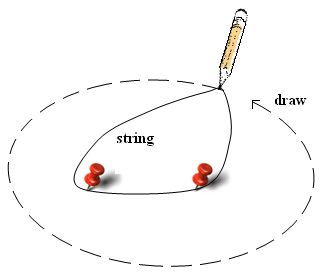
Drawing an ellipse.
For more details on ellipses, visit the Wikipedia ellipse site.
As I said before, circles and ellipses are like cousins. Here's one reason why. If you place the 2 takes closer and
closer the ellipse becomes more and more like a circle and if you place the 2 tacks right next to each other, you do
get a circle. So now we know the difference between a circle and an ellipse and that the Moon's orbit around the Earth
is an ellipse and not a circle. So what?
I'll tell you what. Since the Moon is at one of the foci of the ellipse, the distance to the Moon is not always the
same. So the Moon does not always appear to be the same size - that's what! Technically, when the Moon is closest to
Earth it is at Perigee, while it is at Apogee when it is farthest from Earth (remember apogee
means away). The picture below really shows how different the Moon appears to be from Perigee to Apogee.

Moon at Perigee and Apogee.
(Image courtesy of
John Walker, Fourmilab, Switzerland).
Since solar eclipses are caused by the Earth passing through the Moon's shadow and since there are 2 parts of a
shadow, there are 3 types of solar eclipses:
-
Total eclipse: If you are in the umbra (meaning the entire Moon is directly between you and the
Sun) and the Moon is at or near Perigee (close to the Earth) the Moon will appear big enough to completely block the
Sun:
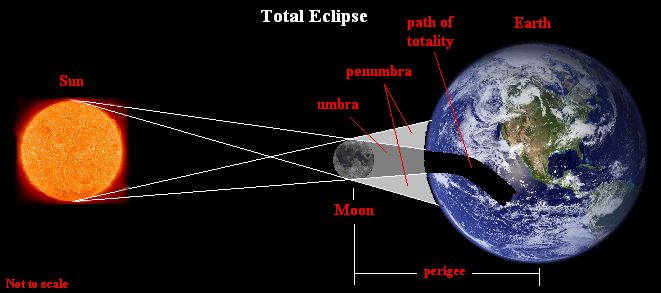
You will see a total eclipse - like this:
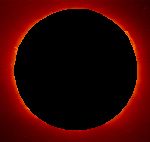
-
Partial eclipse: If you are in the penumbra (meaning the entire Moon is not completely directly between
you and the Sun) you will see a partial eclipse - like this:
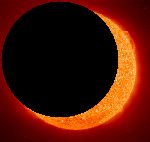
-
Annular eclipse: If you are behind the umbra, or in the antumbra (meaning the Moon is directly between
you and the Sun) and the Moon is NOT at Perigee (not close to the Earth) the Moon will not appear big
enough to completely block out the Sun:
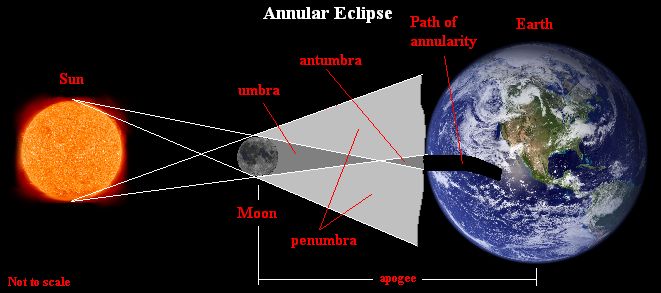
You will see an annular eclipse (it looks like there is a ring around the moon) - like
this:
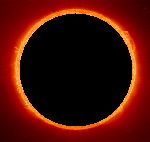
The path of the Moon's umbra shadow across Earth's surface is
called the Path of Totality. The Path of Totality is typically
10,000 miles long but only 100 miles wide. Due to the motions of
the Moon and the Earth the total phase of a solar eclipse is very
brief, rarely lasting more than a few minutes.
To summarize, solar eclipses are caused by the Earth passing through the Moon's shadow.
Also, solar eclipses can only occur during a New Moon!
For more eclipse information visit:
|







